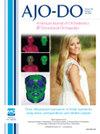Craniofacial and atlas vertebra structures in patients with maxillary palatally displaced canines: A cone-beam computed tomography-based retrospective study
IF 3
2区 医学
Q1 DENTISTRY, ORAL SURGERY & MEDICINE
American Journal of Orthodontics and Dentofacial Orthopedics
Pub Date : 2025-03-25
DOI:10.1016/j.ajodo.2025.02.016
引用次数: 0
Abstract
Introduction
This retrospective cone-beam computed tomography (CBCT) study aimed to analyze the associations between maxillary palatally displaced canine (PDC) with the craniofacial and atlas vertebra structures.
Methods
A total of 94 patients (47 with PDC and 47 normal) were included. Then, their CBCT data were reconstructed and analyzed to measure the 3-dimensional angular positions of canines, the structures of sella turcica, atlas vertebra, and cranial base. Comparisons of continuous variables between 2 groups were performed using the independent samples t test or the Mann-Whitney U test, whereas 1-way analysis of variance or Kruskal-Wallis tests were used for comparisons among multiple groups. Categorical variables were compared using the chi-square test or Fisher exact test, as appropriate. Binary logistic regression analyses, along with Spearman or Pearson correlation analyses, were conducted to determine the associations between variables.
Results
No significant differences were observed in sella turcica structures or the occurrence of ponticulus posticus between the 2 groups (P >0.05). The anterior cranial base length was significantly smaller, and the cranial base angle was significantly larger in subjects with PDC (P <0.05). Moreover, a significant negative correlation was identified between anterior cranial base length and the occurrence of PDC (P <0.05). However, the angular positions of canines showed no significant correlation with any craniofacial variables.
Conclusions
On the basis of CBCT data, the structures of sella turcica and atlas vertebra did not differ between patients with PDC and those with normally erupted canines. However, patients with PDC exhibited a significantly shorter anterior cranial base length and a greater cranial base angle, suggesting a possible developmental link between cranial base morphology and maxillary canines. The explicit relationship and clinical significance of PDC with craniofacial structures require further investigation.
上颌腭移位犬的颅面和寰椎结构:一项基于锥束计算机断层扫描的回顾性研究。
摘要:本研究旨在分析上颌腭移位犬(PDC)与颅面和寰椎结构的关系。方法:共94例患者,其中PDC患者47例,正常患者47例。然后,对它们的CBCT数据进行重建和分析,以测量犬的三维角位置、蝶鞍、寰椎和颅底结构。两组间连续变量比较采用独立样本t检验或Mann-Whitney U检验,多组间比较采用单因素方差分析或Kruskal-Wallis检验。分类变量比较使用卡方检验或Fisher精确检验,视情况而定。二元逻辑回归分析,以及Spearman或Pearson相关分析,进行确定变量之间的关联。结果:两组患者蝶鞍结构及后桥发生率无显著差异(P < 0.05)。PDC患者的前颅底长度明显缩短,颅底角明显增大(P)。结论:基于CBCT数据,PDC患者的蝶鞍和寰椎结构与正常犬齿患者无明显差异。然而,PDC患者表现出明显较短的前颅底长度和较大的颅底角,这表明颅底形态与上颌犬的发育可能存在联系。PDC与颅面结构的明确关系及临床意义有待进一步研究。
本文章由计算机程序翻译,如有差异,请以英文原文为准。
求助全文
约1分钟内获得全文
求助全文
来源期刊
CiteScore
4.80
自引率
13.30%
发文量
432
审稿时长
66 days
期刊介绍:
Published for more than 100 years, the American Journal of Orthodontics and Dentofacial Orthopedics remains the leading orthodontic resource. It is the official publication of the American Association of Orthodontists, its constituent societies, the American Board of Orthodontics, and the College of Diplomates of the American Board of Orthodontics. Each month its readers have access to original peer-reviewed articles that examine all phases of orthodontic treatment. Illustrated throughout, the publication includes tables, color photographs, and statistical data. Coverage includes successful diagnostic procedures, imaging techniques, bracket and archwire materials, extraction and impaction concerns, orthognathic surgery, TMJ disorders, removable appliances, and adult therapy.

 求助内容:
求助内容: 应助结果提醒方式:
应助结果提醒方式:


